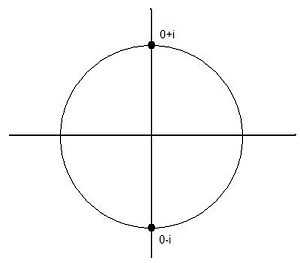Complex Numbers
| | Subject classification: this is a mathematics resource . |
| | Educational level: this is a secondary education resource. |
| | Educational level: this is a tertiary (university) resource. |
| | Resource type: this resource contains a lecture or lecture notes. |
The complex numbers are a set of numbers which have important applications in the analysis of periodic, oscillatory, or wavelike phenomena. They are best known for providing square roots of negative numbers, such as  . Mathematicians denote the set of complex numbers with an ornate capital letter:
. Mathematicians denote the set of complex numbers with an ornate capital letter:  . They are the 5th item in this hierarchy of types of numbers:
. They are the 5th item in this hierarchy of types of numbers:
- The "natural numbers"—
 , 0, 1, 2, 3, ... (There is controversy about whether zero should be included. It doesn't matter.)
, 0, 1, 2, 3, ... (There is controversy about whether zero should be included. It doesn't matter.) - The "integers"—
 , positive, negative, and zero
, positive, negative, and zero - The "rational numbers"—
 , or fractions, like 355/113
, or fractions, like 355/113 - The "real numbers"—
 , including irrational numbers
, including irrational numbers - The "complex numbers"—
 , which give solutions to polynomial equations
, which give solutions to polynomial equations
A complex number is composed of two parts, or components—a real component and an imaginary component. Each of these components is an ordinary (that is, real) number. The complex numbers form an "extension" of the real numbers: If the imaginary component of a complex number is zero, that number is exactly equal to the real number that is its real component.
The complex numbers are defined as a 2-dimensional vector space over the real numbers. That is, a complex number is an ordered pair of numbers: (a, b). The familiar real numbers constitute the complex numbers with second component zero. That is, x corresponds to (x, 0).
The second component is called the imaginary part. Its unit basis vector is called  . The first component is called the real part. Its unit basis vector is just 1. Thus, the complex number
. The first component is called the real part. Its unit basis vector is just 1. Thus, the complex number  can also be written
can also be written  . Numbers with real part of zero are sometimes called "pure imaginary", with the term "complex" sometimes reserved for numbers with both components nonzero.
. Numbers with real part of zero are sometimes called "pure imaginary", with the term "complex" sometimes reserved for numbers with both components nonzero.
While the "invisible" nature of the imaginary component may be disconcerting at first (and the word "imaginary" may be an unfortunate term for it), the complex numbers are just as genuine as the Dedekind cuts and Cauchy sequences that are used in the definition of the "real" numbers.
The complex numbers form a field, with the mathematical operations defined as shown below.
Arithmetic operations
The field operations are defined as follows. These operations are completely compatible with the corresponding operations on real numbers, when the complex numbers involved happen to be real.
Addition
Addition is just the standard addition on the 2-dimensional vector space. That is, add the real parts (first components), and add the imaginary parts (second components).
Letting the complex numbers w and z be defined by their respective components:
we have:
Multiplication
Multiplication has a special definition. It is this definition that gives the complex numbers their important properties.

- When we multiply
 , this definition gives
, this definition gives 
- When we multiply
Writing out the product  in the obvious way, we get the same answer:
in the obvious way, we get the same answer:
This means that, using  , one can perform arithmetic operations in a completely natural way.
, one can perform arithmetic operations in a completely natural way.
Division
Division requires a special trick. We have:
To get the individual components, the denominator needs to be real. This can be accomplished by multiplying both numerator and denominator by  . We get:
. We get:
Due to the miracle of the multiplication by  , all of the manipulations in the preceding line involve familiar ("real") arithmetic. The trick involved making the number
, all of the manipulations in the preceding line involve familiar ("real") arithmetic. The trick involved making the number  from
from  . This operation is known as the complex conjugate, discussed in more detail below. The act of multiplying both numerator and denominator by the conjugate of the denominator is analogous to the operation of "rationalizing the denominator" in ordinary algebra.
. This operation is known as the complex conjugate, discussed in more detail below. The act of multiplying both numerator and denominator by the conjugate of the denominator is analogous to the operation of "rationalizing the denominator" in ordinary algebra.
This division will fail if and only if  , that is,
, that is,  and
and  are both zero, that is, the complex denominator
are both zero, that is, the complex denominator  is exactly zero (both components zero). This is exactly analogous to the rule that real division fails if the denominator is exactly zero.
is exactly zero (both components zero). This is exactly analogous to the rule that real division fails if the denominator is exactly zero.
"Scalar Multiplication"
When we think of the complex numbers as a 2-dimensional vector space over the reals, the question arises: what is the meaning of "scalar multiplication" on this vector space? That is, what happens if we multiply a complex number, represented as a 2-dimensional vector, by a real number. It isn't hard to see that this is nothing but complex multiplication, in which the given "scalar" has been turned into a complex number by setting its imaginary part to zero.
- Example:

However, after one has developed a familiarity with complex numbers and their operations, it is best not to think of the set of complex numbers as a 2-dimensional vector space. This is because mathematicians often use vector spaces in which the underlying "scalar field", (normally the reals) is in fact the complex numbers. That is, one can have a 3-dimensional complex vector space, so that the standard "scalar multiplication" operation on that space actually involves 3 complex multiplications, one by each component of the vector. The theory of Hermitian and unitary operators applies to complex vector spaces.
How to Perform Operations on Complex Numbers
Performing complex operations is quite easy. Just do ordinary algebraic operations, treating "i" as though it were any other variable. For example, we know from elementary algebra that we can work out the addition:

- This works for "i" as well:

- Similarly for multiplication:

- When we use the rule
 , we can remove powers of
, we can remove powers of  greater than 1, so
greater than 1, so
- For division:

Any power of i higher than 1 can be reduced by using the fact that  . For example,
. For example, 
The Fundamental theorem of algebra
The complex numbers form an algebraically closed field. This means that any  degree polynomial can be factored into n first degree (linear) polynomials. Equivalently, such a polynomial has n roots (though one has to count all multiple occurrences of repeated roots.) This statement is the Fundamental Theorem of Algebra, first proved by Carl Friedrich Gauss around 1800. The theorem is not true if the roots are required to be real. (This failure is what led to the development of complex numbers in the first place.) But when the roots are allowed to be complex, the theorem applies even to polynomials with complex coefficients.
degree polynomial can be factored into n first degree (linear) polynomials. Equivalently, such a polynomial has n roots (though one has to count all multiple occurrences of repeated roots.) This statement is the Fundamental Theorem of Algebra, first proved by Carl Friedrich Gauss around 1800. The theorem is not true if the roots are required to be real. (This failure is what led to the development of complex numbers in the first place.) But when the roots are allowed to be complex, the theorem applies even to polynomials with complex coefficients.
The simplest polynomial with no real roots is  , since -1 has no real square root. But if we look for roots of the form
, since -1 has no real square root. But if we look for roots of the form  , we have:
, we have:
For the imaginary part to be zero, one of a or b must be zero. If a is not zero, then b must be zero, and there is no solution. So a must be zero and  must be 1. This means that
must be 1. This means that  , so the roots are
, so the roots are  and
and  , or
, or  .
.
These two numbers,  and
and  , are the square roots of -1.
, are the square roots of -1.
Similar analysis shows that, for example, 1 has three cube roots:
One can verify that

For a given field, the field containing it (strictly speaking, the smallest such field) that is algebraically closed is called its algebraic closure. The field of real numbers is not algebraically closed; its closure is the field of complex numbers.
Polar coordinates, modulus, and phase
Complex numbers are often depicted in 2-dimensional Cartesian analytic geometry; this is called the complex plane. The real part is the x-coordinate, and the imaginary part is the y-coordinate. When these points are analyzed in polar coordinates, some very interesting properties become apparent. The representation of complex numbers in this way is called an Argand diagram.
If a complex number is represented as  , its polar coordinates are given by:
, its polar coordinates are given by:
Transforming the other way, we have:
So 
The radial distance from the origin,  , is called the modulus. It is the complex equivalent of the absolute value for real numbers. It is zero if and only if the complex number is zero.
, is called the modulus. It is the complex equivalent of the absolute value for real numbers. It is zero if and only if the complex number is zero.
The angle,  , is called the phase. (Some older books refer to it as the argument.) It is zero for positive real numbers, and
, is called the phase. (Some older books refer to it as the argument.) It is zero for positive real numbers, and  radians (180 degrees) for negative ones.
radians (180 degrees) for negative ones.
The multiplication of complex numbers takes a particularly interesting and useful form when represented this way. If two complex numbers  and
and  are represented in modulus/phase form, we have:
are represented in modulus/phase form, we have:
But that is just the addition rule for sines and cosines!
So the rule for multiplying complex numbers on the Argand diagram is just:
- Multiply the moduli.
- Add the phases.
One can use this property to find all of the nth roots of a number geometrically. For example, by using these trigonometric formulas:
The three cube roots of 1, listed above, can all be seen to have moduli of 1 and phases of 0 degrees, 120 degrees, and 240 degrees respectively. When raised to the third power, the phases are tripled, obtaining 0, 360, and 720 degrees. But they are all the same angle—zero. So the cubes of these numbers are all just one. Similarly,  and
and  have phases of 90 degrees and 270 degrees. When those numbers are squared, the phases are 180 and 540, both of which are the same angle—180 degrees. So their squares are both -1.
have phases of 90 degrees and 270 degrees. When those numbers are squared, the phases are 180 and 540, both of which are the same angle—180 degrees. So their squares are both -1.
One can apply this property to the nth roots of any complex number. They lie equally spaced on a circle. This is DeMoivre's theorem.


Euler's formula
A careful analysis of the power series for the exponential, sine, and cosine functions reveals the marvelous Euler formula:
of which there is the famous case (for θ = π):
More generally, 
Conjugates
The complex conjugate, or just conjugate, of a complex number is the result of negating its imaginary part. The conjugate is written with a bar over the quantity:  . All real numbers are their own conjugates.
. All real numbers are their own conjugates.
All arithmetic operations work naturally with conjugates—the sum of the conjugates is the conjugate of the sum, and so on.
It follows that, if P is a polynomial with real coefficients (so that its coefficients are their own conjugates)
If  is a root of a real polynomial, then, since zero is its own conjugate,
is a root of a real polynomial, then, since zero is its own conjugate,  is also a root. This is often expressed as "Non-real roots of real polynomials come in conjugate pairs." We saw that above for the cube roots of 1—two of the roots are complex and are conjugates of each other. The third root is its own conjugate.
is also a root. This is often expressed as "Non-real roots of real polynomials come in conjugate pairs." We saw that above for the cube roots of 1—two of the roots are complex and are conjugates of each other. The third root is its own conjugate.
Transcendental functions
The higher mathematical functions (often called "transcendental functions"), like exponential, log, sine, cosine, etc., can be defined in terms of power series (Taylor series). They can be extended to handle complex arguments in the completely natural way, so these functions are defined over the complex plane. They are in fact "complex analytic functions". Just about any normal function one can think of can be extended to the complex numbers, and is complex analytic. Since the power series coefficients of the common functions are real, they work naturally with conjugates. For example:
Complex functions
The general study of functions that take a complex argument and return a complex result is an extremely rich and useful area of mathematics, known as complex analysis. When such a function is differentiable, it is called a complex analytic function, or just analytic function.
What Does "Algebraically Closed" Mean?
The complex numbers were invented in order to solve the problem of finding roots of polynomials that have real coefficients. But how about polynomials with coefficients that are themselves complex? Is the set of complex numbers big enough to contain the roots of those? One could imagine a situation in which the answer would be "no", and we might have to invent some new set, say "hypercomplex numbers". And, to get roots of polynomials that have hypercomplex coefficients, we might have to invent "superdupercomplex numbers", and so on.
That unpleasant scenario didn't happen. The complex numbers are sufficient for roots of all polynomials, including those with complex coefficients. We say that the complex numbers are closed under the operation of finding roots of polynomials, or just algebraically closed.
Mathematicians call a set "closed" under some operation if that operation, applied to elements of the set, yields a result also in the set. So we can say that:
- The natural numbers are closed under addition and multiplication.
- The integers are also closed under subtraction.
- The rationals are also closed under division (by a nonzero divisor.)
- The reals are also closed under the operation of finding least upper bounds, or the operation of finding limits of convergent Cauchy sequences.
- The complex numbers are also closed under the operation of finding roots of polynomials.
Applications
It may seem improbable that an artificial construction like this, which does not arise in ordinary measurements, has extensive applications. But complex numbers in fact are extremely important in many areas of pure and applied mathematics and physics. Basically, any description of oscillatory phenomena can benefit from a formulation in terms of complex numbers.
The applications include these:
- Theoretical mathematics:
- algebra (including finding roots of polynomials)
- linear algebra—vector spaces, inner products, Hermitian and unitary operators, Hilbert spaces, etc.
- eigenvalue/eigenvector problems
- number theory—This seems improbable, but it is true. The Riemann zeta function, and the Riemann hypothesis, are very important in number theory. For a long time, the only proofs of the prime number theorem used complex numbers. The Wiles/Taylor proof of Fermat's Last Theorem uses modular forms, which use complex numbers.
- Applied mathematics
- eigenvalue/eigenvector problems
- Fourier and Laplace transforms
- linear differential equations
- stability theory
- Electrical engineering
- alternating current circuit analysis
- filter design
- antenna design
- Theoretical physics
- quantum mechanics
- fundamental particle physics
- electromagnetic radiation
- optics
The quadratic formula
The need for complex numbers arises from attempts to solve quadratic equations. Some of these equations, such as x2 + 1 = 0, are "impossible". (The solutions, in this case, are the "impossible" square roots of -1.)
The solutions of quadratic equations:  are given by the quadratic formula:
are given by the quadratic formula:
 [1].
[1].
The case b2 < 4ac is the troublesome case. But with complex numbers, the two square roots
are just
Rectangular Form
If we let the complex number  then the following information holds true:
then the following information holds true:
If  then
then  . That is,
. That is,  is a real number, and can be called 'pure real'. Conversely, if
is a real number, and can be called 'pure real'. Conversely, if  then
then  , and
, and  is 'pure imaginary'. We can refer specifically to the real and imaginary parts (
is 'pure imaginary'. We can refer specifically to the real and imaginary parts ( and
and  ) of
) of  respectively as follows:
respectively as follows:  and
and  .
.
Whilst the real numbers are readily visualised by considering a straight "number line", complex numbers are best seen as being positions on a plane. This plane would have one axis considered to be the real axis, the equvalent to the x axis on the cartesian plane (where  ), and the other an imaginary axis, the equvalent to the y axis on the cartesian plane (where
), and the other an imaginary axis, the equvalent to the y axis on the cartesian plane (where  ).
).
Any number that is a multiple of i is an imaginary number.
But, if  , and
, and  , what does
, what does  equal?
equal?
- So we say

- and

so z is a complex number, that is a number that has a real part and an imaginary part.
Polar Notation
We have already seen the cartesian representation of complex numbers, expressed in terms of real and imaginary parts. Alternatively, we can represent a complex number by a magnitude and direction,  and
and  . In this representation a complex number z can be represented as,
. In this representation a complex number z can be represented as,

where,
This also allows one to write,
When r = 1 this is known as w:Euler's formula.[2][3]
Note: To represent a complex number graphically, simply draw a vector on the X - Y plane with the X axis  and the Y axis
and the Y axis  .
.
Complex Plane
It is useful to be able to represent complex numbers geometrically, just as we are able to represent real numbers geometrically on the number line. Moreover, we don’t need any genuinely new ideas to do this.
We know that each pair of real numbers (x, y) corresponds uniquely to a point P(x, y) in the cartesian plane.
To represent complex numbers geometrically, we use the same representation: a complex number z = x+iy is represented by the point P(x, y) in the plane, as in the following diagram:
When the plane is used to represent complex numbers in this way, it is called the Complex Plane or the Argand Diagram.






































